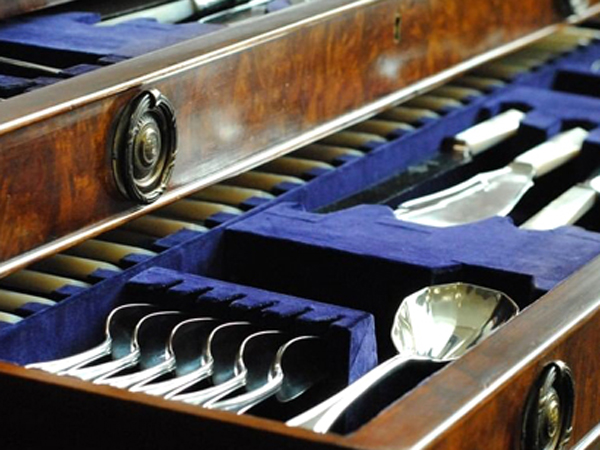Antique and Vintage Silver Flatware and Cutlery Sets
Browse our extensive collection of stunning antique and vintage silver flatware including canteens of cutlery and sterling silver cutlery sets
Browse these categories under "Antique and Vintage Silver Flatware and Cutlery Sets"
Load more
AC Silver offers a fine selection of sterling silver flatware including many impressive boxed canteens of cutlery.
The diverse sterling silver flatware collection includes impressive examples from the Victorian and Edwardian eras including pieces designed in the Art Deco style.
Andrew Campbell only selects the finest antique silver cutlery sets and canteens to AC Silver’s inventory

One factor of owning a silver cutlery service is the storage of the pieces. The nature of the storage is not only dependant on the size of the home, but also how frequently the service will be used.
One of the most traditional household storage solutions is the cutlery drawer, with separate compartments for silver spoons, knives, and forks; allowing the user to access each piece individually with ease. With the same consideration a caddy or container could be used if the flatware selection were being used on a regular basis; this would allow the pieces to be more portable and would perhaps save the space in a drawer. These storage solutions would perhaps be suitable for pieces which were being utilised on a regular basis, however if the service were only for special occasion there would be a high development of tarnish on silver stored in this manner.
Alternatively, when purchasing a silver cutlery service, it can often come fitted to a box specifically made to fit the flatware, this is called a canteen box. There are many variations of materials used to create such a box, however they typically come with a felt or velvet lining. The box composition itself varies correlates with the size of the service, with options of a lift up lid and multiple drawers. This storage arrangement does aid with reducing tarnishing due to the nature of the box, and encasing each piece.
Not all sterling silver cutlery sets are fitted to a canteen box, and when this is the cutlery rolls are good substitutes. These felt cutlery roll not only protects the items in storage but also significantly reduces tarnishing to silver cutlery. Here at AC Silver, we provide cutlery rolls with each canteen of cutlery, so the service can be kept in its best condition when not in use.
The dictionary definition of flatware is: relatively flat tableware such as utensils, forks, knives, spoons, used at the table for serving and eating food.
Knives have been used as tools, weapons and eating utensils since prehistoric times, yet it is only in more recent times that knives have been used specifically for table use.
Around 3000 – 700 BC metal blade knives were originally made from copper and then bronze until it was discovered that iron provided a sharper, longer-lasting knife edge.
During the Middle Ages (500 AD – mid 1400’s) knives were a uniquely personal possession retained by ‘the owner’ for individual use. (It was not unusual for a person to be buried with their personal eating knife). These knives had a sharply pointed blade used to spear food to transfer it from the plate to the mouth.
With time, knives with blunt ends, wider, curved blades and pistol grip handles were made to facilitate taking food to the mouth in a safer fashion.
Originally spoons were crude pieces made of shell or bone. Even when knives were made of metal, spoons continued to be made from more organic materials.
The Romans introduced pewter, bronze and silver spoons to Britain in approximately 50 AD. Like knives, spoons were originally items kept for personal use alone.
From 500 AD onwards, the Vikings and Saxons introduced more decorative spoons with leaf-shaped bowls and carved ends, but it was during the Cromwellian period in the mid 1600’s when the bowl of the spoon became more ovoid in shape and the spoon handle flattened towards the end, becoming closer to the familiar shape recognised today.
As with knives, spoons were initially personal possessions, representing a degree of personal prosperity.
- Rinse after use
- Don''''t soak in water overnight
- Wash in hot, soapy water, then rinse clean with hot water
- Clean any hard to reach areas with an old, soft toothbrush
- Dry immediately with a soft cotton cloth
If you use a dishwasher for your silver flatware keep the detergent to a minimum and avoid mixing stainless steel and silver cutlery in the same basket as this could damage the silver pieces.



































